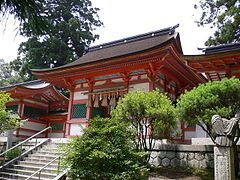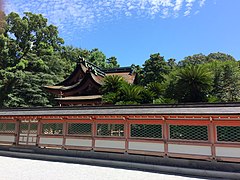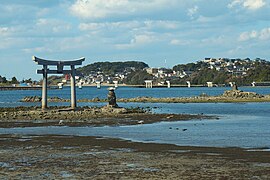Kashii-gū
The Kashii-gū ( Japanese. 香 椎 宮 ) is a Shinto shrine in Kashii, once located in a rural area, now part of the eastern district of the city of Fukuoka ( Fukuoka Prefecture , Japan ).
According to legendary tradition, the Empress Jingū built a shrine Kashii no miya ( 橿 日 宮 ) here in 200 when her husband, the Tennō Chūai , died fighting the Kumaso people. A small "old shrine" located in the immediate vicinity of today's main hall is said to go back to this foundation. Historically secured mentions can only be found from the year 723. Since Chūai is said to have found his final resting place here, older texts also use the name Kashii-byō (Kashii mausoleum 香 椎 廟 ).
At the center of worship are Chūai and Jingū, their son, the fifteenth Tennō of the Ōjin kingdom , and the three Sumiyoshi deities of the sea. There are other small branch shrines for the deities Inari , Takeuchi Sukune and others on the site . a. m. In addition to the Inari shrine, the Keiseki jinja (literally chicken stone shrine) with a protective deity for chickens and children attracts many visitors.
Outside the shrine area on a flat rock called Mijima (literally: island 御 島 ) in the immediate vicinity of the coast is the Mijima shrine ( Mijima jinja 御 島 神社 ), in which the deity Watatsumi ( Watatsumi no kami 綿 津 見 神 ) resides. Legend has it that Empress Jingū once washed her hair here and arranged it into the hairstyle of men before leading her troops on a campaign in Korea.
The structure of the main hall ( honden ), known as the "Kashii construction" ( 香 椎 造 , kashii-zukuri ) , whose current shape goes back to the last new building in 1801, can only be found here. The building is divided into three parts, side wings with gates and a multi-forked roof. This hall is not accessible.
Since the Nara period, the shrine has belonged to the small group of shrines called Chokusaisha , which on certain occasions are allowed to receive the Tennō's "imperial ambassadors" ( chokushi , 勅使 ) in an elaborate ceremony. This used to happen every 60 years, 1804 was shortened to ten years. The 800 meter long path to the shrine area, lined with camphor trees , is therefore also known as the “Imperial Ambassador Path”.
The priesthood was once held for generations by four families who took turns in the ministry every four years.
Up to the middle of the 19th century there were a number of Buddhist temples of the Shingon school in the vicinity of the shrine , but these were destroyed after 1868 in the course of the "separation of Shinto and Buddhism" ( shinbutsu-bunri ). Today only a small temple of the deity Benzaiten in the immediate vicinity bears witness to these times of 'mixing Shinto and Buddhism' ( shinbutsu-shugo ).
gallery
Torii and Mijima Shrine (right)
Web links
- More photographs from Kashii-gū - Japanese
- Kashii-zukuri in the Japanese Architecture and Art Net System - English
References and comments
- ↑ A people named in the Chronicle Nihongi who are said to have lived in the south of Kyushu .
- ↑ As a result of modern land reclamation, this place is now enclosed on three sides by land.
- ↑ This protective deity for seafarers, fishermen, etc. is worshiped in a number of shrines on the coast of North Kyushu. The name component wata goes back to the Korean word pada (sea).
- ↑ In Kyushu there are only two of these shrines particularly connected to the courtyard, besides the Kashii shrine that of Usa .
Coordinates: 33 ° 39 ′ 12.5 ″ N , 130 ° 27 ′ 9.6 ″ E






